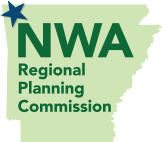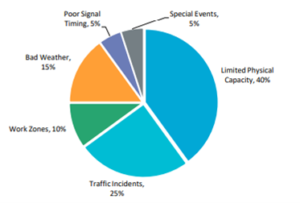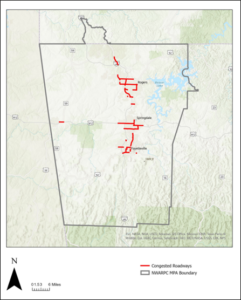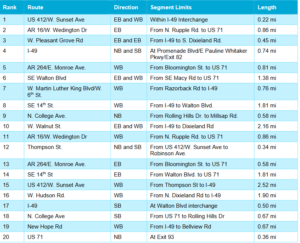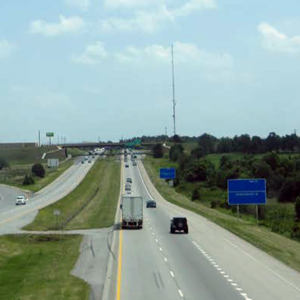Transportation
Congestion Management Process
The 2022 Congestion Management Process (CMP) was adopted on May 25, 2022 by the NWARPC/Policy Committee
The Congestion Management Process (CMP) is a systematic approach, collaboratively developed and implemented throughout a metropolitan region, that provides for the safe and effective management and operation of new and existing transportation facilities through the use of demand reduction and operational management strategies. The CMP is required to be developed and implemented as an integral part of the metropolitan planning process in Transportation Management Areas (TMAs) – urbanized areas with a population over 200,000, or any area where designation as a TMA has been requested. The CMP represents the state-of-the-practice in addressing congestion, and should be considered in metropolitan areas that are facing current and future congestion challenges.
The Congestion Management System has been described as a “7 Step” process; with the addition of a new “first step,” the Congestion Management Process is an “8 Step” process, as follows:
- Develop Congestion Management Objectives
- Identify Area of Application
- Define System or Network of Interest
- Develop Performance Measures
- Institute System Performance Monitoring Plan
- Identify and Evaluate Strategies
- Implement Selected Strategies and Manage Transportation System and
- Monitor Strategy Effectiveness.
SOURCES FOR TRAFFIC CONGESTION
The graphic below illustrates the main sources for traffic congestion:
Sources of Congestion – National Summary:
For Live Traffic Conditions, Construction Zones, or Winter Road Conditions please visit the Arkansas Department of Transportation IDriveArkansas link.
Congestion in Northwest Arkansas
NWARPC has access to FHWA’s National Performance Management Research Data Set (NPMRDS), a national database of probe-vehicle-based speed and travel time data. This data enables the NWARPC to analyze and track congestion on the roadways on an ongoing basis. The CMP network was identified as the roadway network for which NPMRDS data is available. The CMP covers 826 directional miles of roadway. The map blow identifies the congested corridors based on the 2019 travel conditions.
Congestion Corridors in 2019:
Top 20 Congested Segments
The 20 most congested segments based on the excessive vehicular delay per mile are summarized in the table below. This table was developed by ranking segments by excessive vehicular delay per mile. Detailed list of all congested segments is provided in Appendix A of the CMP Report.
CMP Objectives and Performance Measures
Through an extensive public involvement process, the NWARPC 2045 Metropolitan Transportation Plan (MTP) identified and adopted five goals and supporting objectives. The MTP Goals and Objectives create the groundwork for future policies to ensure that Northwest Arkansas is able to meet the demands of the transportation system in the most cost-effective manner.
The NWARPC 2045 MTP goals and objectives were used as the basis for the development of the CMP objectives. The MTP objectives which are related to congestion were selected as the objectives for the CMP.
The NWARPC CMP objectives are listed below:
1. Address congestion and system reliability and maximizing efficiency and effectiveness through Management and Operations.
2. Encourage the use of intelligent transportation systems (ITS) that improve the emergency response to incidents and clearing of incidents to improve safety and system reliability.
3. Implement safety strategies that reduce congestion by reducing fatality and serious injury crashes.
4. Maintain and preserve existing highway, transit and other facilities in good condition to minimize congestion related to work zones, road closures, and service interruptions.
5. Endeavor to reduce congestion by supporting alternative transportation modes.
6. Encourage land development patterns that promote transportation choice and efficiency.
7. Prioritize congestion reduction on truck/freight corridors to improve freight movement and economic vitality.
8. Minimize energy consumption and air pollution on a system-wide basis by reducing congestion and improving reliability.
The CMP identifies several performance measures that relate to these goals and objectives. Tracking and annually reporting these performance measures will allow NWARPC to evaluate the success of its efforts to manage congestion.
Congestion Management Strategies
A wide variety of potential strategies are available to mitigate congestion in NWARPC, many of which already have been implemented or studied through regional plans, modal plans, and other studies. The potential strategies are presented in a congestion management “toolbox” that is based on best practices throughout the United States. The plan also identifies additional strategies that NWARPC should consider. Some of these are statewide strategies (e.g., travel demand management), while others are focused on congested corridors.
Congestion Management Strategic Action Plan
The final section of the plan is an action plan that details activities that NWARPC should undertake collaboratively over the next few years to implement the Congestion Management Plan. Actions are divided into the following groups:
• Data Collection, Evaluation, and Monitoring—Developing better information and data to track the success of efforts to mitigate congestion.
• Planning Activities—Actions to more fully develop congestion management strategies in specific focus areas.
• Implementation Activities—Actions to implement projects to directly reduce congestion.
• Coordination Activities—Ongoing intra and interagency coordination to implement the CMP.
NWARPC should also implement specific congestion management actions already recommended in other planning documents. Implementing congestion-reducing projects listed in the TIP also is a critical action element to implement the CMP.
Previous CMP Reports:
- Congestion Management Process (CMP) Final Report – May 22, 2015
- Congestion Management Process (CMP) Report – July 21, 2013
- Northwest Arkansas Regional Planning Commission Congestion Management Process (CMP) Update – Jan. 16, 2014
- Map of the Adopted Congestion Management Network – NWARPC Policy Committee, July 24, 2013
- Map of the CMP Network Traffic Control Devices Map of the CMP Network Posted Speeds
